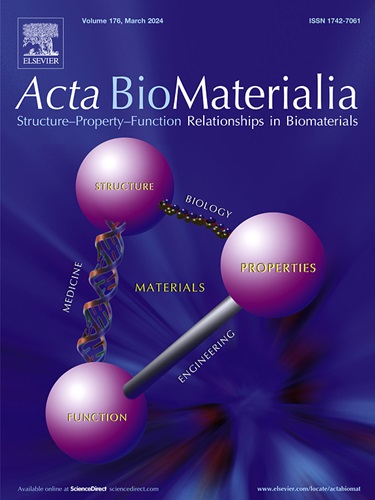Fine-tuning of material properties by catch bonds
IF 9.4
1区 医学
Q1 ENGINEERING, BIOMEDICAL
引用次数: 0
Abstract
Semiflexible polymer networks are ubiquitous in biological systems, including a scaffolding structure within cells called the actin cytoskeleton. The polymers in these networks are interconnected by transient bonds. For example, actin filaments in the cytoskeleton are physically connected via cross-linker proteins. The mechanical and kinetic properties of the cross-linkers significantly affect the rheological properties of the actin cytoskeleton. Here, we employed an agent-based model to elucidate how the force-dependent behaviors of the cross-linkers determine the material properties of passive networks without molecular motors and the force generation of active networks with molecular motors. The cross-linkers are assumed to behave either as a slip bond, whose dissociation rate increases with forces, or as a catch-slip bond, whose dissociation rate decreases with forces at low force level but increases with forces at high force level. We found that catch-slip-bond cross-linkers can simultaneously increase both the stress and the strain at the yield point. Through a systematic variation in the force dependence of the catch-slip bonds, we identified the specific parameter regimes that enable network reinforcement and enhanced extensibility simultaneously. Specifically, we found that a sufficiently large force threshold for the catch-slip transition is essential for maintaining dynamic force-bearing elements that turnover continuously—a mechanism not achievable with slip bonds. Additionally, we demonstrate that such force-dependent redistribution of the catch-slip bonds substantially enhances internal contractile forces generated by a motor in active networks.
Statement of significance
Polymer networks are ubiquitous in industrial and biological systems. The polymers in these networks are often interconnected by transient bonds. The transient bonds behave as a slip bond whose dissociation rate is proportional to forces or as a catch-slip bond whose dissociation rate decreases with increased force (catch) at low force level but increases with increased force (slip) at high force level. In this study, we computationally tested different types of catch-slip bonds to define how the material properties of polymer networks are fine-tuned by each property of molecular bonds. We found that catch-slip bonds can increase both stress and strain at a yield point, which is impossible to achieve without the catch-slip bonds.

捕获键对材料性能的微调。
半柔性聚合物网络在生物系统中无处不在,包括细胞内被称为肌动蛋白细胞骨架的脚手架结构。这些网络中的聚合物通过瞬态键相互连接。例如,细胞骨架中的肌动蛋白丝通过交联蛋白进行物理连接。交联剂的力学和动力学性质显著影响肌动蛋白细胞骨架的流变性能。在这里,我们采用了一个基于智能体的模型来阐明交联剂的力依赖行为如何决定无分子马达的被动网络的材料特性和有分子马达的主动网络的力产生。假设交联剂表现为滑移键,其解离率随力的增加而增加;或者表现为捕获-滑移键,其解离率随力的降低而降低,但随力的增加而增加。我们发现,抓滑键交联剂可以同时增加屈服点的应力和应变。通过捕获-滑动键的力依赖性的系统变化,我们确定了能够同时增强网络和增强可扩展性的特定参数制度。具体来说,我们发现一个足够大的力阈值对于保持持续翻转的动态受力元件是必不可少的,这是滑移键无法实现的机制。此外,我们证明了这种力依赖于捕获-滑动键的再分配大大增强了主动网络中电机产生的内部收缩力。意义说明:聚合物网络在工业和生物系统中无处不在。这些网络中的聚合物通常通过瞬态键相互连接。瞬态键表现为滑移键,其解离率与力成正比;或表现为捕获-滑移键,其解离率在低力水平下随力(捕获)的增加而降低,而在高力水平下随力(滑移)的增加而增加。在这项研究中,我们通过计算测试了不同类型的捕获-滑动键,以确定聚合物网络的材料性质如何通过分子键的每种性质进行微调。我们发现抓滑键可以在屈服点增加应力和应变,而没有抓滑键是不可能实现的。
本文章由计算机程序翻译,如有差异,请以英文原文为准。
求助全文
约1分钟内获得全文
求助全文
来源期刊

Acta Biomaterialia
工程技术-材料科学:生物材料
CiteScore
16.80
自引率
3.10%
发文量
776
审稿时长
30 days
期刊介绍:
Acta Biomaterialia is a monthly peer-reviewed scientific journal published by Elsevier. The journal was established in January 2005. The editor-in-chief is W.R. Wagner (University of Pittsburgh). The journal covers research in biomaterials science, including the interrelationship of biomaterial structure and function from macroscale to nanoscale. Topical coverage includes biomedical and biocompatible materials.
 求助内容:
求助内容: 应助结果提醒方式:
应助结果提醒方式:


